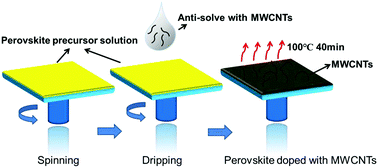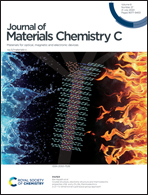Carbon-based HTL-free modular perovskite solar cells with improved contact at perovskite/carbon interfaces†
Abstract
Carbon-based hole transport layer (HTL)-free perovskite solar cells (PSCs), wherein carbon layers effectively function as both HTLs and back electrodes, have attracted widespread interest due to their outstanding advantages. However, the power conversion efficiency (PCE) remains much lower as compared to the state-of-the-art PSCs with conventional organic HTLs and noble metal electrodes, mainly due to the intrinsically inferior contact at the perovskite/carbon interface and high sheet resistance of carbon electrodes. To deal with these issues, C-based HTL-free PSCs with a modular design were fabricated, i.e., the final PSCs were assembled by two individual elements (semi-cell A and charge collector B) under pressure. Moreover, the mixed perovskite active layers were obtained using a modified anti-solvent dripping method, in which the oxidized multi-walled carbon nanotubes (O-MWCNTs) were dispersed in an anti-solvent solution and its concentration was optimized for the best overall performance. Results indicated that the contact quality at the perovskite/carbon interface was remarkably improved by using this innovative method; the corresponding mechanism was attributed to the penetration of O-MWCNTs into both layers and the formation of a perovskite/carbon hetero-junction, thus forming a fast hole transport pathway from a perovskite to a carbon electrode with reduced recombination loss. As a result, the PCE increased up to 8.99%, and the unencapsulated PSCs retained 80% of their initial PCE under ambient conditions without intentionally controlling humidity for 500 h. We reported a feasible and effective strategy to improve the perovskite/carbon interface in C-based HTL-free PSCs.



 Please wait while we load your content...
Please wait while we load your content...